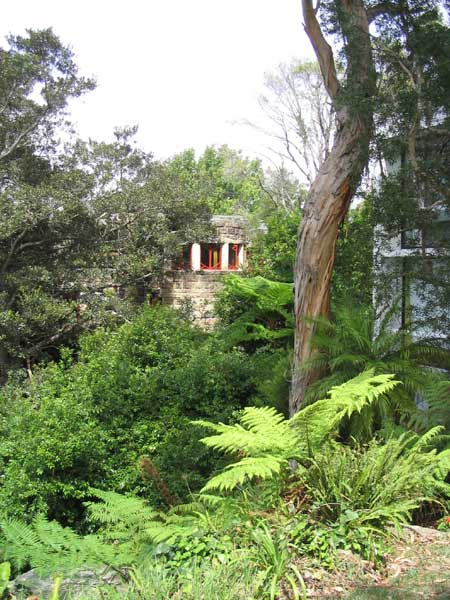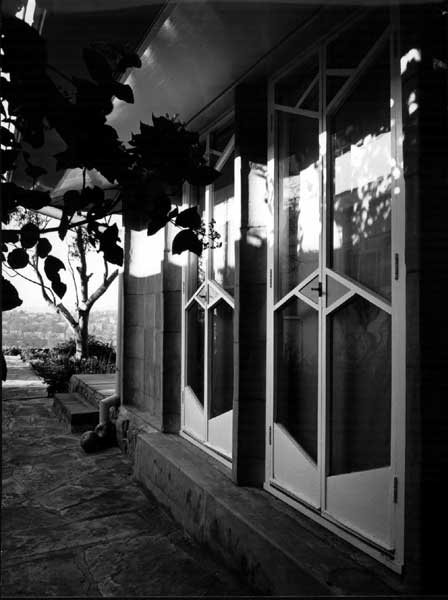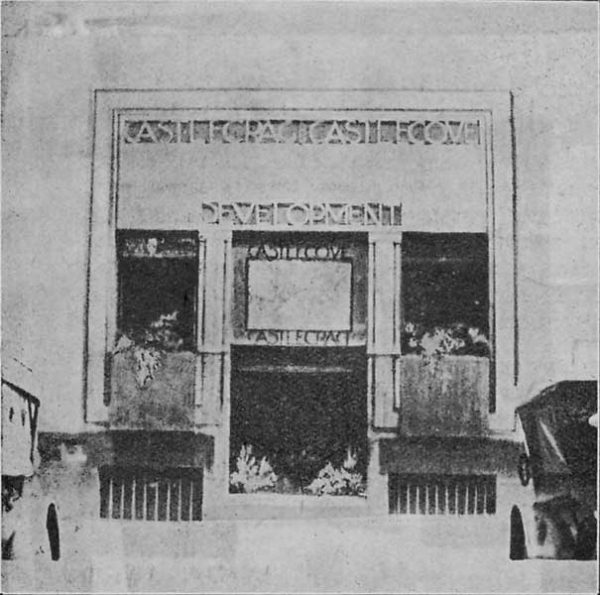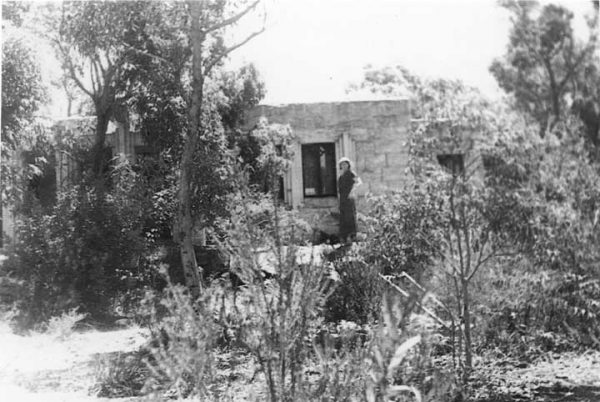‘…each individual can feel that the whole of the landscape is his. No fences, no boundaries, no red roofs to spoil the Australian landscape; these are some of the features that will distinguish Castlecrag.’
Walter Burley Griffin had been enchanted by Sydney Harbour and its foreshores ever since he arrived by ship from Chicago USA in 1913 to take up the position of Federal Capital Director of Design and Construction after winning the Canberra competition the previous year. When Walter Griffin resigned from this position in 1920, he and his architect wife Marion Mahony Griffin poured their vast energies into establishing a residential development that was sympathetic to this beautiful natural environment, unlike the red roofs and grid streets that characterised Sydney at the time.
Greater Sydney Development Association (GSDA)
In 1919 Griffin began the search for a site on Sydney Harbour suitable for comprehensive development and eventually secured an option to purchase 263 hectares (650 acres) of land with 6.44 kilometres (4 miles) of water frontage which included large portions of the areas now known as Castlecrag, Castle Cove and Middle Cove. He formed a company, the Greater Sydney Development Association (GSDA), to purchase and develop the estate. It was to be a model of how to subdivide, develop and build within, and with respect for, the Australian landscape.
Griffin had considerable experience in estate planning and development in the United States and he continued his town planning activity after arriving in Australia. He planned a number of estates around Melbourne as well as town centres for Leeton and Griffith in the Murrumbidgee Irrigation Area of NSW and schemes for Port Stephens and Jervis Bay.
Griffin believed that better suburban environments could be created by careful planning that respected the landscape character of an area itself together with the provision of community open spaces within an increased number of allotments. These theories were to be tested and proven in his work at Castlecrag.
The formation of the GSDA involved a number of shareholders of diverse backgrounds who supported the Griffins and their ideals and who appointed Walter Griffin as Managing Director. Griffin chose the name ‘Castlecrag’, having been inspired by Edinburgh Rock — a sandstone outcrop forming the highest point within the rocky peninsula projecting into Middle Harbour. Shareholders of GSDA were offered a free block of land if they built a house upon it and the resulting ‘demonstration houses’ were constructed in 1921 and 1922, the first years of the estate.
The Griffins’ vision for Castlecrag
The Griffins took up residence in Castlecrag in the autumn of 1925, after many years of travelling between their offices in Melbourne and Sydney and participated actively in establishing a unique community.
The Griffins personally undertook the design of the roads and allotments with the winding roads following the contours of the landforms. Communal areas were linked together with a network of walkways to provide open spaces, retain views and achieve maximum amenity for all residents. Equally important was respect for the native Australian landscape which the Griffins had come to understand and admire. In Castlecrag they set out to demonstrate that architecture and landscape should be integrated so that ‘…each individual can feel that the whole of the landscape is his. No fences, no boundaries, no red roofs to spoil the Australian landscape; these are some of the features that will distinguish Castlecrag.’
The Griffins sought to keep the existing bushland canopy of Castlecrag’s sandstone peninsula as intact as possible. Their aim of conserving the significant landscape resources was original. No other development company in the history of Sydney has ever given such a fantastic gift to future residents: interlocked open spaces and over four miles of almost continuous open space along the foreshore.
The Griffins’ vision for Castlecrag was of a community quite different from a typical Sydney suburb. Such a radical vision could only be maintained in practice by the application of covenants to each allotment imposing requirements as to the type of development that should occur. These covenants required approval for the design of buildings and placed restrictions on roofing materials, and required owners adjoining reserves to contribute to their management and upkeep. The controls were to ensure that buildings harmonis ed with the natural landscape and the overall vision is quite breathtaking in its intention and scope. Unfortunately subsequent development often has been unsympathetic to the Griffins’ vision to the detriment of the suburb and a loss to the community as a whole.
A place of international interest
Despite unsympathetic development, Castlecrag has retained much of its unique character. It remains a place of international interest for its vision and its achievement of town planning and building goals which are outside the ordinary. It reveals the Griffins as guiding figures who were quite passionately dedicated to the betterment of their fellows.
Castlecrag is unique not only for its planning but also for the substantial number of Griffin houses located in its streets. Fifteen houses were built to Griffin designs, ranging from the very modest GSDA No.1 Dwelling to the sophisticated Fishwick Residence. There is evidence of more than 30 other houses that Griffin designed for Castlecrag, but were never built. In the plan below prepared by the Griffins’ office, the footprints of the built houses are in black and the unbuilt projects appear hatched. These unbuilt projects include the Towler Residence, Hong Nam House, Wearne & Finlay Residence, GSDA’s Managers Quarters, Wilmore Residence, Wirth Residence, GSDA Dwelling No.3, Paton Residence, Holman Residence, Duncan Resi dence (No.1), Symington Residence and others (see Turnbull & Navaretti, 1998).
The protected network of public reserves and walkways – which for its time was innovative and radically different from other suburbs – still provides access and recreation spaces for residents and visitors alike. In addition, the community spirit that the Griffins and their associates engendered can still be found and experienced as a living heritage.
Castlecrag is recognised internationally as an example of planning with nature. It is a living monument to the Griffins and to the generations of residents who have shared their love for this special place and acted accordingly. This is discussed further in ‘Legacy at Castlecrag’.
Author
Martin O’Donoghue is a senior architect in mid sized practice working on projects throughout New South Wales. He is interested in all forms of art and architecture including painting, dance, theatre and cinema. He has been a committee member of the Walter Burley Griffin Society from 2001 to the present and a resident of Castlecrag since 1989.
Further reading
Deans, Edgar and Duncan, Frank, Memories of Early Castlecrag, transcription from videotaped interview, 1988 (pdf 724kb)
Harrison,Peter, Walter Burley Griffin: landscape architect. Canberra, National Library of Australia, 1995.
Leslie, Esther (comp), The suburb of Castlecrag: a community history. Sydney, Willoughby Municipal Council, 1988.
Turnbull, Jeff and Navaretti, Peter Y (eds), The Griffins in Australia and India: the complete works and projects of Walter Burley Griffin and Marion Mahony Griffin. Melbourne, Miegunyah Press (Melbourne University Press), 1998.
Walker, Meredith, Kabos, Adrienne and Weirick, James, Building for nature: Walter Burley Griffin and Castlecrag. Sydney, Walter Burley Griffin Society, 1994.
Walter Burley Griffin Society, The Griffin Legacy: Castlecrag Heritage (brochure pdf 752kb). Sydney, Walter Burley Griffin Society & NSW Heritage Office, 2004.
.




